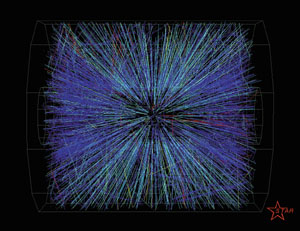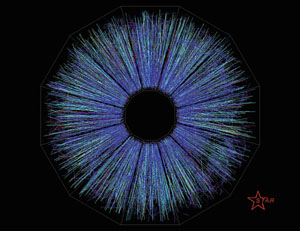

On Monday 12 June a new high-energy machine made its stage debut as operators in the main control room of Brookhaven’s Relativistic Heavy Ion Collider (RHIC) finally declared victory over their stubborn beams. Several weeks before, Derek Lowenstein, chairman of the laboratory’s collider-accelerator department, had described repeated attempts to get stable beams of gold ions circulating in RHIC’s two 3.8 km rings as “like learning to drive at the Indy 500!”.
With beams finally circulating in the collider’s twin rings on a collision course at an energy of 30 GeV per nucleon, the waiting STAR detector captured the first spectacular images of particles streaming from a head-on collision point, showing an impressive shower of about 1000 tracks, but this was just a foretaste of bigger things to come. Soon, collisions were also seen by the BRAHMS, PHENIX and PHOBOS detectors.
The result is great news for the thousands of physicists, engineers and support staff who have been working since 1991 to get RHIC up and running, and for physicists everywhere who have been anticipating RHIC’s debut.
“These are the most spectacular subatomic collisions ever witnessed by humankind, representing the culmination of many years of hard work,” said Satoshi Ozaki, associate laboratory director for RHIC. It was a proud moment for Ozaki, who returned to Brookhaven from Japan to oversee the construction and commissioning of this challenging machine.
The high temperatures and densities achieved in the RHIC collisions should, for a fleeting moment, allow the quarks and gluons to roam in a soup-like plasma – a state of matter that is believed to have last existed millionths of a second after the Big Bang. Information from RHIC experiments will round out the quark-gluon plasma knowledge gained through experiments using nuclear beams at lower energies at CERN’s SPS synchrotron.
RHIC construction began in 1991, and the project was completed last year, when all parts of the machine were initially tested and operated as a complete system, but just short of physics operation. Construction and commissioning costs totalled $600 million.
Nuclei destined for RHIC originate in the laboratory’s Tandem Van de Graaff, proceed into the booster and then travel on to the venerable Alternating Gradient Synchrotron (AGS), which first came into operation in 1960. The AGS injects nuclear beams into RHIC for experiments.
For RHIC, bunches of nuclei are injected into each of the two rings. Then, with both rings filled, the ions will be whipped to 70 GeV/nucleon. With stable beams coasting around the rings, the nuclei collide head-on, eventually at the rate of tens of thousands of collisions per second.
Principal RHIC components were manufactured by industry, in some cases through co-operative ventures that transferred technology developed at Brookhaven to private industry.
The RHIC tunnel is filled with 1740 superconducting magnets in two rings, which bend and focus the particles. Dipole and quadrupole magnets were built by the Northrop-Grumman Corporation on Long Island, and sextupole magnets were built by Everson Electric, in Bethlehem, Pennsylvania. Brookhaven built the corrector magnets and other special magnets.
The RHIC tunnel configuration provides for six areas where the circulating beams cross and where collisions take place. Four areas now contain detectors – two large ones, STAR and PHENIX, and two smaller assemblies, PHOBOS and BRAHMS. All together, close to 1000 scientists from 90 research institutions representing 19 countries are working on RHIC experiments.








